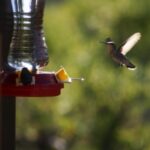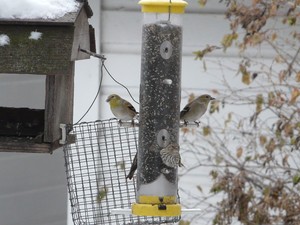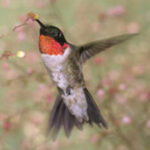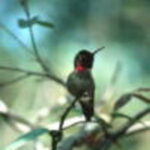Choosing the right hummingbird feeder has as much to do with your personal preferences as it does the hummingbird’s feeding habits. These tiny jewels aren’t fussy about the type of feeder you provide as long as its filled with sweet nectar-but the type of feeder does determine how easy it is to care for and the overall appearance of your hummingbird feeding station.
1. Ease of assembly. Hummingbird feeders should come apart easily allowing you to clean all parts thoroughly. Look for one that has a fill hole large enough to accommodate a bottle brush and has parts that are easily reached for cleaning. The easier it is for you to disassemble and clean your hummingbird feeder, the more likely you are to keep it sparkling clean.
2. Consider the size of the feeder. Large feeders may be appropriate if you attract large numbers of hummingbirds to your yard, but if your regular visitors number fewer than 5 or 6, a small feeder may be a better choice. Nectar should be changed every two or three days to keep it fresh. Select a hummingbird feeder that your hummingbirds will empty from feeding every day or two.
3. Plastic vs Glass. Plastic feeders tend to deteriorate over time as the plastic often becomes cloudy. They are also a bit more difficult to clean as scrubbing may scratch the surface. Glass feeders maintain their original appearance.
4. Price. If price is a concern, go ahead and buy the inexpensive plastic feeder, but realize that you will likely need to replace it every year or two. Perches break, flowers fall off and plastic becomes cloudy with repeated exposure to the sun. More expensive feeders typically last longer and maintain their beauty.
5. Color. Many hummingbird feeders have bright red parts-or may even have a red reservoir, but red isn’t necessary. Although they may get hummingbird attention a bit quicker as these tiny birds stop to investigate, hummingbirds will happily feed without any red at all.
6. Shape. Hummingbird feeders come in two basic shapes; the bottle feeder and saucer feeder. The Cornell Lab of Ornithology explains that tube feeders tend to drip when left in the sun, as air in the top of the feeder expands in the heat and forces nectar out of the feeder ports. Placing the feeder out of direct sunlight reduces the risk of dripping.
7. Number of Feeders. Hummingbirds are territorial and fight fiercely over the food supply. Hanging several small feeders around the yard attracts more hummingbirds and reduces competition.
The type of hummingbird feeder you choose doesn’t really matter to the hummingbird. He will feed from nearly any container, as long as it is clean and filled with fresh nectar. Perches are convenient and allow you to observe your feathery visitors up close, but they aren’t necessary. Hummingbirds feed while hovering and don’t need a perch at the feeder. Do yourself a favor and choose a hummingbird feeder that is easy to take apart and easy to clean. You’ll be glad you did.
For information on making your own hummingbird feeders, see DIY Hummingbird Feeders from Recycled Bottles
SOURCES:
Cornell Lab of Ornithology






